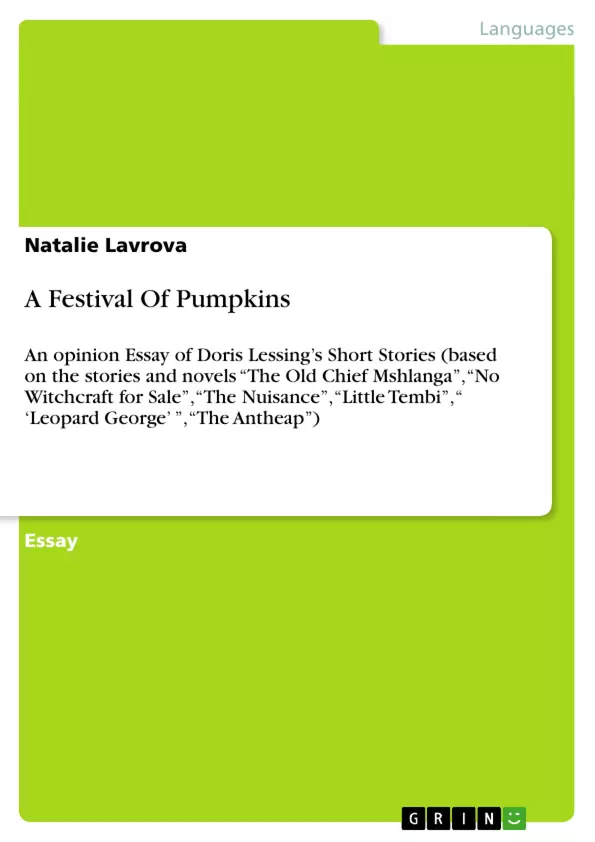The essay is based on some of the short stories and novels by D. Lessing, which are centered around the colonization of Africa and ruthless suppression and ousting of African people's cultural heritage. The title of the paper is an allusion to the phrase used in the story "The Old Chief Mshlanga". In the context of the story it can be regarded as a sustained metaphor: a festival of pumpkins symblises the vestiges of the recent dwellings of a big African familily that had been forced to retreat to a special reserve.
Doris Lessing (born 1919) is one of the few writers whose literary style almost immediately strikes you as down-to-earth, and at the same time pathetic, pregnant with emotional tension and almost detective implications. D. Lessing was born in Iran, but as a she was a small girl, her family moved to Rhodesia (modern Zimbabwe), Africa. Her life there shaped her literary inclinations and tragic perception of reality, which is palpable in every story of hers. The heartfelt leitmotif of her stories and novels is the colonization of Africa and its tragic, partly unforeseen ramifications that mostly affected indigenous population of Africa.
The cultural, spiritual and social divide between Europe and Africa is the essence of both internal and external conflicts, as well as the unequal status of two diametrically opposed forces represented by human beings, whose skin colour prevents them from reaching a consensus. The colonization of Africa involved ruthless suppression and ousting of African people’s culture under the guise of importing a civilized way of life and European values, both of which proved to be alien to Africans, whose traditional tribal way of life turned out to be tenacious and not easily supplanted.
Frequently asked questions
Who is Doris Lessing?
Doris Lessing (born 1919) is a writer known for her down-to-earth literary style, emotional depth, and exploration of social and political themes.
What are some common themes in Doris Lessing's work?
Lessing's work frequently explores the cultural, spiritual, and social divide between Europe and Africa, often focusing on the impact of colonization on indigenous populations.
What is the significance of the setting in Lessing's stories?
The setting, particularly Rhodesia (modern Zimbabwe) in Africa, plays a crucial role in shaping the narrative and highlighting the tragic consequences of colonization.
What does the "festival of pumpkins" symbolize in the context of Lessing's writing?
The "festival of pumpkins" is a recurring motif representing the resilience and enduring presence of the African people and their culture, even in the face of displacement and oppression. It symbolizes a thwarted celebration and the vestiges of a former life.
How does Lessing portray the relationship between colonizers and the colonized?
Lessing depicts the relationship as complex and unequal, highlighting the suppression of African culture and the imposition of European values, leading to internal and external conflicts.
What is the "stick-and-carrot policy" mentioned in the text?
The "stick-and-carrot policy" refers to the strategies used by colonizers involving punishment ("stick") and reward ("carrot") to control and manipulate the indigenous population. This reinforces the power imbalance and forces conformity.
What does Lessing mean by "a vein of richness"?
Lessing uses the phrase "a vein of richness" to describe the indigenous people's deep connection to the land and their cultural wealth, which is often overlooked or devalued by the white settlers who prioritize monetary value.
How does the story illustrate the impact of cattle treading upon the neighbouring kraal?
The incident involving cattle trampling crops serves as a catalyst for the displacement of the African family. The disproportionate punishment (demand for excessive cattle) highlights the injustice and systemic oppression faced by the indigenous population under colonial rule. The family chooses to retreat rather than meet the master's demands, because the remaining cattle wouldn't be enough to feed the Africans.
What happens to the village after the family moves?
After the family moves, the village is abandoned and overgrown with pumpkins, serving as a reminder of the life that once thrived there before colonization. The pumpkins are so tenacious as to evade all the efforts of uprooting them.
- Quote paper
- Natalie Lavrova (Author), 2010, A Festival Of Pumpkins, Munich, GRIN Verlag, https://www.grin.com/document/147443



